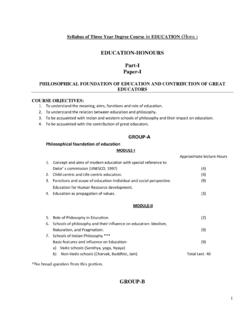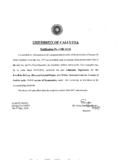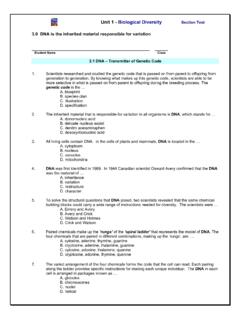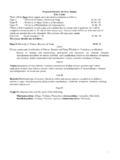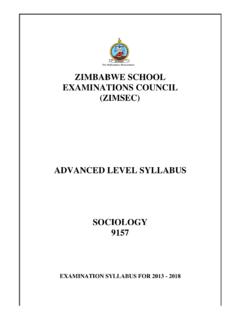Transcription of SYLLABUS FOR B. Sc. ZOOLOGY (HONOURS & GENERAL) …
1 Page 1 of 25 SYLLABUS FOR B. Sc. ZOOLOGY ( honours & general ) 2016 U N I V E R S I T Y O F C A L C U T T A Page 2 of 25 U N I V E R S I T Y O F C A L C U T T A DRATF SYLLABUS FOR B. Sc. ZOOLOGY ( honours & general ) 2016 Paper unit No. of Classes Group Topic Marks Gr. Tot. P A R T I H O N O U R S Paper 1 unit I 75 Group A Diversity & Functional Anatomy of Non-chordate Forms 25 50 Group B Diversity & Functional Anatomy of Chordate Forms 25 unit II 75 Group A Cell biology 15 50 Group B Genetics 35 Paper 2 unit I 75 Developmental Biology 50 unit II 75 Practical Animal forms and Comparative anatomy, Cytological methods and Genetics, Osteology and Embryology 50 PART II honours Paper 3 unit I 75 Group A Systematics 15 50 Group B Evolutionary Biology & Adaptation 25 Group C Animal Behaviour 10 unit II 75 Group A Ecology 25 50 Group B Biodiversity and Conservation 25 Paper 4 unit I 75 Group A Animal physiology 25 50 Group B Biochemistry 25 unit II 75 Practical Ecological methods, Systematics and Evolutionary Biology.
2 Animal Physiology and Biochemistry 50 PART III honours Paper 5 unit I 75 Molecular Biology 50 unit II 75 Group A Parasitology and Microbiology 25 50 Group B Immunology 25 Paper 6 unit I 75 Integration Biology and Homeostasis 50 unit II 75 Animal Biotechnology & Applied ZOOLOGY 50 Paper 7 Practical 75 Molecular biology, Parasitology and Microbiology, Immunology, Histological techniques and staining methods, Adaptation 100 Paper 8 Practical 75 Instrumentation, Report on Environmental audit, Field work assessment, Biostatistics 100 Page 3 of 25 PART - I (PAPER 1: unit I) (Diversity & Functional Anatomy of Non-chordate & Chordate Forms) [Note: Classification will be dealt in practical section of the course] Group A: Non chordate Marks = 25 1.
3 Animal architecture and Bauplan concept. 2. Classification up to Phylum of Protozoa (according to Levine et. al., 1981); from Phylum to living Subclass with reasons of other non-chordates (according to Ruppert and Barnes, 1994)(Invertebrate chordates excluded) 3. Movement: Ameoboid movement: Mechanism of pseudopodia formation by cytoskeletal proteins. Flagellar movement in Euglena ultra structure of Flagella and mechanism of locomotion 4. Reproduction in Paramoecium sp. with special reference to conjugation 5. Canal system in Porifera 6. Polymorphism in Siphonophores and its evolutionary significance 7. Coral reef: Types, distribution in India and conservation aspects 8.
4 Metamerism in Annelida and its evolutionary significance 9. Respiration: Terrestrial respiration in Periplaneta Structure of tracheal system and mechanism of respiration. Aquatic respiration in Prawn structure and types of gills and mechanism of respiration. 10. Nervous system in Pila and effect of torsion on it. Nervous system in Aplysia and effect of de-torsion on it. 11. Water vascular system in Asterias sp. 12. Structural organization of Placozoans Group B: Chordate Marks = 25 1. Basic body plan in chordates. Basic concept of chordate classification. Classification up to living Subclass of Fish and Aves; up to living Order of Amphibia and Reptilia; up to Infra-class of Mammals (according to J.)
5 Z. Young 1981) 2. Structure of pharynx and feeding mechanism in Branchiostoma sp. 3. Metamorphosis in Ascidia justification in the light of survival of the species 4. Comparative anatomy & structural organization of aortic arches in vertebrates. 5. Accessory respiratory structure in teleosts 6. Paedomorphosis with special reference to Axolotl larva 7. Non-poisonous and poisonous snakes; Poison apparatus and biting mechanism of poisonous snake 8. Distinguishing features of Ratites and Carinates 9. Feather of Birds its type, development, structure, colour variations as adaptive feature and function 10. Exoskeletal structure in Mammals hair, horns and antlers 11. Distinguishing features of Artiodactyla and Perissodactyla.
6 12. Functional anatomy of ruminant stomach in cow. [Note: Eight short questions of 2 marks to be set from both the Groups, of which 5 will be answered. 4 questions from Group A and 4 questions from Group B to be set. Each question will be of 10 marks. Students will answer 2 questions from each group] Page 4 of 25 PAPER 1, unit II (Cell Biology and Genetics) Group A: Cell Biology Marks = 15 1. Principles of microscopy: Light Microscopy; Phase contrast microscopy; Electron microscopy (EM) - Scanning EM (SEM) and Transmission EM (TEM) 2. Cell Membrane: Chemical composition and properties of membrane components, Fluid mosaic model of membrane structure, membrane fluidity and its experimental demonstration, membrane asymmetry, selective permeability of the membranes, membrane transport, Liposomes, Freeze-etching and freeze fracture technique for membrane study.
7 3. Mitochondria- Marker enzymes distribution, mitochondrial biogenesis, Symbiont hypothesis of mitochondrial origin; mitochondrial DNA. 4. Endo membrane system of cell: Signal peptide hypothesis, N-linked & O-linked glycosylation in ER and Golgi body; protein transport and trafficking. GROUP B: GENETICS [Marks = 35] 1. Properties of DNA: Chargaff s rule, Re-naturation and De-naturation, Hyper-chromic shift, c-value paradox. 2. Concept of genetic information flow a. D N A R e p l i c a t i o n i. In p ro k a r y o t e s: Semi-conservative replication; unit of replication, enzymes involved, replication origin replication fork, replication slippage ii. In e u k a r y o tes: Or i gi n , p o l ym e r a s e e n z ym e s a n d t e l o m e r i c r e p l i c a t i o n b.
8 Tr a n s c r i p t i o n i n p ro k a r y o t e s a n d e u k a r y o t e s: i. Transcription factors: Transcription activators, Repressors, Motifs (only Basic helix loop helix [BHLH], Leucine zipper definition and example) ii. Formation of initiation complex (in Prokaryotes and RNA Polymerase II in Eukaryotes) iii. RNA polymerase, chain elongation and termination. c. RNA processing: Polyadenylation, methyl capping, splicing. d. Protein synthesis in prokaryotes: formation of initiation complex, initiation factors, elongation and elongation factors, termination 3. Allele concept: Cis-trans test for allelism, Multiple allele: ABO blood group in human; Isoallele: White eye locus in Drosophila; Complex locus: Lozenge locus in Drosophila.
9 4. Linkage: Complete and Incomplete linkage; Experiments by Bridges 5. Crossing over: Three point mapping method; cytogenetic evidence of crossing over in Drosophila by Stern s experiment. 6. Mutation a. Types: transition, transversion, frame shift, nonsense, mis-sense, hypomorphic, null, lethal, forward, backward, suppressor, enhancer. b. Mutagens and their effects: UV radiation, ionizing radiation, 5-BU, EMS. c. Mutation detection: X linked mutation detection in Drosophila by ClB method, Attached X methods, Autosomal mutation detection by CyLPm (balanced lethal) method, and detection of biochemical mutation in Neurospora crassa. Page 5 of 25 7. Sex determination in Drosophila and Human 8.
10 Dosage compensation a. In Drosophila: Hyper activation of X by msl, mle and roX RNA followed by histone Ac16 acetylation b. In human: Inactivation of X by XIST RNA followed by DNA methylation 9. Chromosomal Aberration: Types and examples from Drosophila and human only. 10. Cytoplasmic inheritance: Shell coiling in snail, kappa particle in Paramoecium. [Note: Eight short questions of 2 marks are to be set from both the Groups, of which 5 will be answered. 3 questions from Group A and 5 questions from Group B are to be set. Each question will be of 10 marks. Students will answer 1 question from Group A and 3 questions from Group B] PAPER 2, unit I DEVELOPMENTAL BIOLOGY (Marks = 50) 1.



